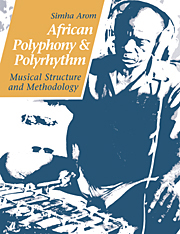Book contents
- Frontmatter
- Contents
- List of illustrations
- Foreword by György Ligeti
- Preface
- Acknowledgements
- BOOK I THE MUSIC OF THE CENTRAL AFRICAN REPUBLIC
- BOOK II AFRICAN POLYPHONIC MUSIC
- BOOK III TECHNICAL TOOLS: METHODS OF RECORDING POLYPHONIC MUSIC FOR TRANSCRIPTION
- 1 The need for transcription
- 2 The difficulties of transcription
- 3 Earlier methods
- 4 Towards a new method
- 5 Theoretical assumptions
- 6 Technical equipment: description and use
- 7 From recording to transcription
- 8 Checking the results
- 9 Potentialities
- 10 Anthropological validity
- BOOK IV THEORETICAL TOOLS
- BOOK V THE ORGANISATION OF TIME IN AFRICAN MUSIC
- BOOK VI STRUCTURAL PRINCIPLES AND THEIR APPLICATION
- Conclusion
- Bibliography
4 - Towards a new method
Published online by Cambridge University Press: 27 January 2010
- Frontmatter
- Contents
- List of illustrations
- Foreword by György Ligeti
- Preface
- Acknowledgements
- BOOK I THE MUSIC OF THE CENTRAL AFRICAN REPUBLIC
- BOOK II AFRICAN POLYPHONIC MUSIC
- BOOK III TECHNICAL TOOLS: METHODS OF RECORDING POLYPHONIC MUSIC FOR TRANSCRIPTION
- 1 The need for transcription
- 2 The difficulties of transcription
- 3 Earlier methods
- 4 Towards a new method
- 5 Theoretical assumptions
- 6 Technical equipment: description and use
- 7 From recording to transcription
- 8 Checking the results
- 9 Potentialities
- 10 Anthropological validity
- BOOK IV THEORETICAL TOOLS
- BOOK V THE ORGANISATION OF TIME IN AFRICAN MUSIC
- BOOK VI STRUCTURAL PRINCIPLES AND THEIR APPLICATION
- Conclusion
- Bibliography
Summary
We are now about to describe a new method which has enabled us to obtain the results presented in this work. It came, not as a brainstorm, but as a result of the kind of long and sometimes tortuous processes, as is often the case. The reader may find it helpful if we outline the main stages in the process which led to its development; we therefore hope he or she will excuse the personal nature of some aspects of the following presentation.
In 1967, we were working on the monodic song-tales of the Ngbaka people in the Central African Republic. These pieces have no regular accentuation and are performed a cappella, i.e., they contain no materialised metric or rhythmic point of reference. We were faced with the problem of finding out how to determine the periodicity of these songs, which meant discovering the key to their temporal organisation. It occurred to us that an answer to this question might be found if we first recorded the song and then asked the singer to record the same piece again, this time clapping his hands. We naturally avoided telling him exactly how this should be done. The Ngbaka performer would then straightforwardly provide us with the basic pulsation for the piece involved. We hoped to obtain a new recording in this way, containing enough metric reference points to enable us to transcribe the durations within the song. The singer's handclaps must be intimately connected with the music, and could therefore leave no doubt as to their accuracy, and consequently, their validity as reference points.
- Type
- Chapter
- Information
- African Polyphony and PolyrhythmMusical Structure and Methodology, pp. 103 - 105Publisher: Cambridge University PressPrint publication year: 1991

